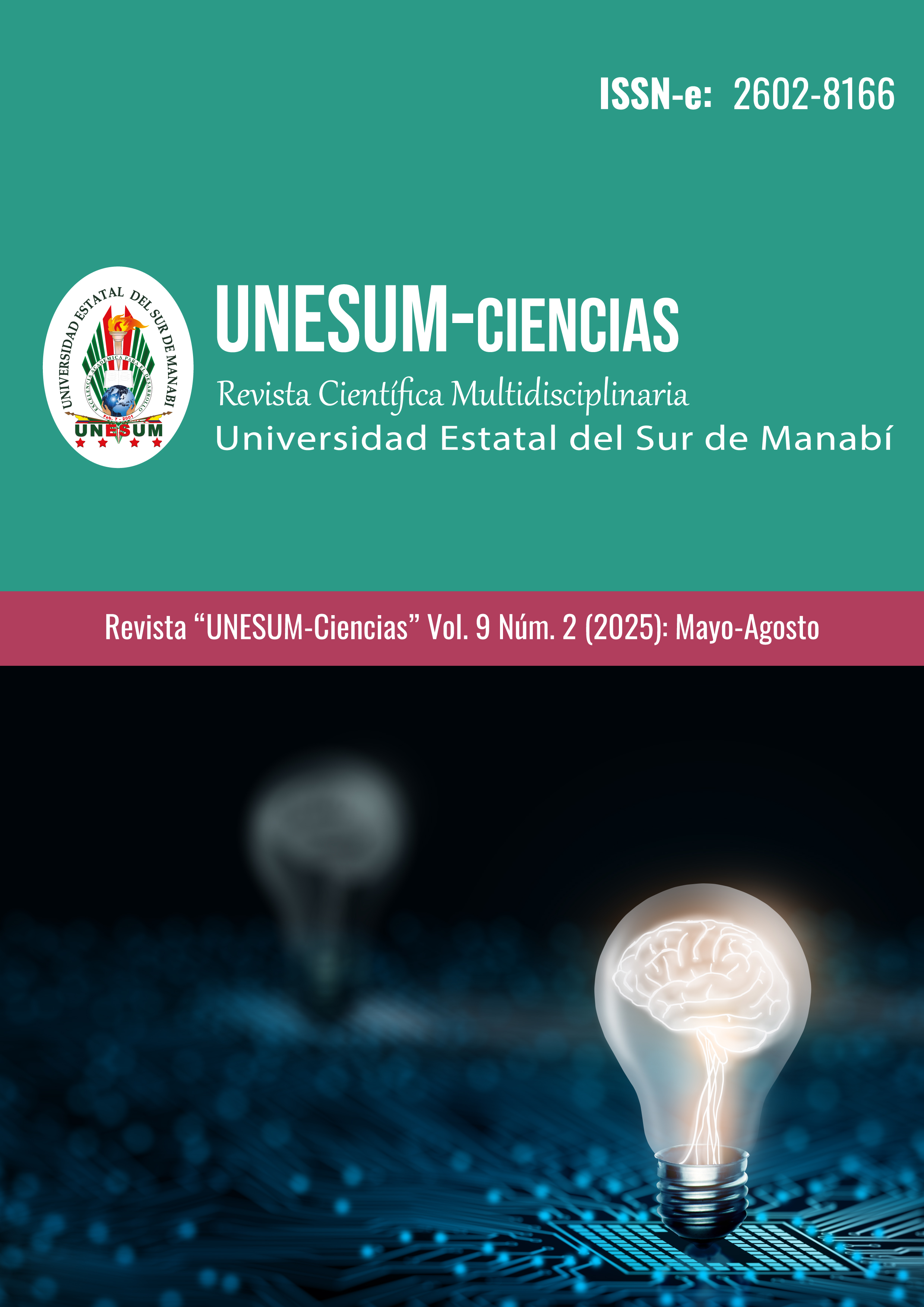Viabilidad económica y social del tratamiento híbrido de aguas residuales con cal y Eichhornia crassipes en comunidades rurales
DOI:
https://doi.org/10.47230/unesum-ciencias.v9.n2.2025.152-161Palabras clave:
Tratamiento de aguas residuales, Cal, Eichhornia crassipes, Viabilidad económica, Impacto social, SostenibilidadResumen
El acceso a agua de calidad para riego es un desafío global, especialmente en comunidades rurales. Este estudio evaluó la viabilidad económica y social de una tecnología híbrida con cal y Eichhornia crassipes para tratar aguas residuales en Joa, Ecuador. Con un costo inicial de $300 por hectárea y operativos de $50 anuales, los beneficios incluyeron un aumento del 20 % en productividad agrícola y $150 anuales en ahorros médicos por familia. El análisis costo-beneficio mostró una relación de 2,5, evidenciando alta rentabilidad. El sistema mejoró la calidad del agua y redujo enfermedades relacionadas, consolidándose como una solución sostenible y replicable en comunidades con recursos limitados.
Descargas
Citas
Ahmed, M. T., Gad, A. A., & Mousa, R. M. (2020). Low-cost wastewater treatment technologies for improving water quality and agricultural productivity in rural Egypt. Agricultural Water Management, 242, 106392. https://doi.org/10.1016/j.agwat.2020.106392
Banco Mundial. (2020). Gestión de recursos hídricos en América Latina y el Caribe: Retos y oportunidades. Recuperado de https://www.worldbank.org
Dölle, K., Wang, Q., & Tong, J. (2021). Water hyacinths (Eichhornia crassipes) – Application for secondary wastewater treatment and biomass production. Journal of Advances in Biology & Biotechnology, 24(1), 52–61. https://doi.org/10.9734/JABB/2021/V24I130196
FAO. (2020). El agua y la agricultura: Perspectivas globales y desafíos locales. Organización de las Naciones Unidas para la Alimentación y la Agricultura. Recuperado de http://www.fao.org
Gallego-Schmid, A., & Tarpani, R. R. Z. (2019). Life cycle assessment of advanced wastewater treatment options for water reuse in agriculture. Resources, Conservation & Recycling, 148, 123-132. https://doi.org/10.1016/j.resconrec.2019.05.024
Khan, S., Shahnaz, M., Jehan, N., Rehman, S., Shah, M. T., & Din, I. (2019). Drinking water quality and human health risk in Charsadda district, Pakistan. Journal of Cleaner Production, 208, 1188-1197. https://doi.org/10.1016/j.jclepro.2018.10.126
López-Morales, C. A., Sánchez-Cerón, L., & Romero-Fernández, M. G. (2020). Rural water management in Latin America: Role of affordable technologies in sustainable agriculture. Journal of Rural Studies, 77, 197-206. https://doi.org/10.1016/j.jrurstud.2020.05.011
Mishra, A., & Maiti, A. (2017). Phytoremediation of heavy metals using water hyacinth: A sustainable approach. Environmental Science and Pollution Research, 24(7), 6396-6409. https://doi.org/10.1007/s11356-016-8357-7
Okumu, S. O., Mwangi, S. N., Njagi, E. N. M., & Wandiga, S. O. (2018). Environmental implications of water hyacinth (Eichhornia crassipes) proliferation and its control in Lake Victoria. Environmental Monitoring and Assessment, 190(6), 351. https://doi.org/10.1007/s10661-018-6726-7
Pozo, G. (2011). Eficiencia del lechuguín en la remoción de nitratos en aguas residuales agrícolas (Tesis de maestría). Universidad Nacional Autónoma de México.
Rezania, S., Ponraj, M., Din, M. F. M., Songip, A. R., Sairan, F. M., & Chelliapan, S. (2014). The diverse applications of water hyacinth with main focus on sustainable energy and production for new era: An overview. Renewable and Sustainable Energy Reviews, 41, 943-954. https://doi.org/10.1016/j.rser.2014.09.006
Sarkar, S., Mandal, A., Das, S., & Banerjee, S. (2020). Decentralized wastewater treatment using low-cost biochar-based filters: A sustainable approach for rural communities. Journal of Water, Sanitation and Hygiene for Development, 10(4), 785-795. https://doi.org/10.2166/washdev.2020.171
Seguil, L. D., Silva, C., & Oliveira, H. (2022). Neutralization of acidic wastewater using lime in rural settings. Environmental Chemistry Letters, 20(3), 505-512. https://doi.org/10.1007/s10311-018-0811-y
Silva, J. (2023). Wastewater treatment and reuse for sustainable water resources management: A systematic literature review. Sustainability, 15(14), 10940. https://doi.org/10.3390/su151410940
Tetteh, E. K., Rathilal, S., Muchatibaya, G., & Armah, E. K. (2019). Low-cost sand filters for potable water supply in sub-Saharan Africa: Review and recommendations. Water Practice and Technology, 14(3), 648-658. https://doi.org/10.2166/wpt.2019.051
UNESCO. (2021). Informe Mundial sobre el Desarrollo del Agua: Valorar el agua. Organización de las Naciones Unidas para la Educación, la Ciencia y la Cultura. Recuperado de https://unesdoc.unesco.org
WWAP (Programa Mundial de Evaluación de los Recursos Hídricos). (2021). Informe Mundial de las Naciones Unidas sobre el Desarrollo de los Recursos Hídricos: Valoración del Agua.
Yadav, R., Joshi, H., & Tripathi, S. (2015). Achieving sustainable agriculture with treated municipal wastewater. International Journal of Biological, Biomolecular, Agricultural, Food and Biotechnological Engineering, 9(7), 644-647. https://doi.org/10.5281/zenodo.1338912
Zambrano, P., Mera, J., & Chávez, R. (2023). Impacto ambiental del uso de aguas residuales en la agricultura de Manabí. Journal of Environmental Management and Engineering, 3(2), 115-126. https://doi.org/10.1007/s10668-020-00776-0
Zhang, Z., Chen, H., Zhang, W., & Tian, X. (2021). Decentralized wastewater treatment technologies in rural China: Current status and perspectives. Journal of Cleaner Production, 319, 128580. https://doi.org/10.1016/j.jclepro.2021.128580
Descargas
Publicado
Cómo citar
Número
Sección
Licencia
Derechos de autor 2025 RENÉ GRAS RODRÍGUEZ, Alfredo Lesvel Castro Landin, Silvia Gabriela González Cruzatty

Esta obra está bajo una licencia internacional Creative Commons Atribución 4.0.




